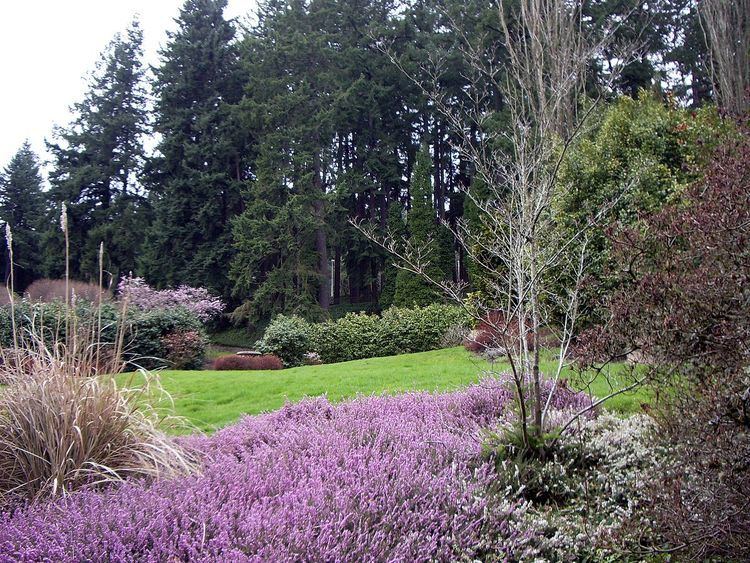Created 1909 | Area 166 ha Phone +1 503-823-2525 | |
 | ||
Operated by Portland Parks & Recreation Address 4001 Southwest Canyon Road, Portland, OR 97221, USA Hours Open today · 5AM–10PMSaturday5AM–10PMSunday5AM–10PMMonday5AM–10PMTuesday5AM–10PMWednesday5AM–10PMThursday5AM–10PMFriday5AM–10PMSuggest an edit Similar International Rose Test Garden, Portland Japanese Garden, Pittock Mansion, Oregon Zoo, Lan Su Chinese Garden Profiles | ||
Washington Park is a public urban park in Portland in the U.S. state of Oregon. It includes a zoo, forestry museum, arboretum, children's museum, rose garden, Japanese garden, amphitheatre, memorials, archery range, tennis courts, soccer field, picnic areas, playgrounds, public art and many acres of wild forest with miles of trails. Washington Park covers more than 410 acres (166 hectares) on mostly steep, wooded hillsides which range in elevation from 200 feet (61 m) at 24th & W Burnside to 870 feet (265 m) at SW Fairview Blvd. It comprises 159.7 acres (64.63 hectares) of city park land that has been officially designated as "Washington Park" by the City of Portland, as well as the adjacent 64-acre (26 ha) Oregon Zoo and the 189-acre (76 ha) Hoyt Arboretum, which together make up the area described as "Washington Park" on signs and maps.
Contents
History
The City of Portland purchased the original 40.78 acres (16.5 hectares) in 1871 from Amos King for $32,624, a controversially high price for the time. The area, designated "City Park", was wilderness with few roads. Thick brush, trees and roaming cougar discouraged access. In the mid-1880s, Charles M. Meyers was hired as park keeper. A former seaman without landscape training, he transformed the park by drawing on memories of his native Germany and European parks. By 1900, there were roads, trails, landscaped areas with lawns, manicured hedges, flower gardens, and a zoo. Cable cars were added in 1890 and operated until the 1930s. The City of Portland constructed two reservoirs in the park in 1893 and 1894.
In 1903, John Charles Olmsted of Olmsted Brothers, a nationally known landscape architecture firm, recommended several changes to the park including the present name, location of the entrance, separate roads and pedestrian paths, and replacement of formal gardens with native species. The name was officially changed from City Park to Washington Park in 1909.
When the Multnomah County Poor Farm Hillside Farm west of Washington Park closed in 1922, the 160 acres (64.75 hectares) were donated to the City of Portland to be used as a park, which later became Hoyt Arboretum.
Portland's zoo was founded in Washington Park in 1888 near where the reservoirs are presently located. It moved in 1925 to what is now the Japanese Garden, and moved again in 1959 to its present location at the park's southern edge. The only surviving structure from the old zoo is the elephant barn, now converted into a picnic shelter and decorated with tile mosaic of various animals and a life-size brick relief sculpture of an elephant and calf.
The City of Portland plans to demolish the two existing outdoor reservoirs, then replace them with underground reservoirs covered by reflecting pools, due to their age and a federal mandate to cover all reservoirs. The $67 million project has attracted opposition from historical preservationists and residents concerned about construction impacts.
Notable features
The veterans memorial, zoo, children's museum, forestry center and the MAX station surround a large parking lot in the southwestern portion of the park. The arboretum is located just to the north of these. The gardens, amphitheater, playgrounds and the Holocaust Memorial are in the northeast section of the park.
Statues and fountains
In 2001, a memorial bench and plaque north of the Lewis and Clark Memorial were created to honor the Portland born journalist John Reed. The plaque has a quotation by Reed on his native city:
Public access
The Washington Park light rail station provides regional public transit access to the park's west end, including the Oregon Zoo. Seasonal public transit service within the park is provided by the Washington Park Shuttle, which connects with MAX light rail at the Washington Park station and operates from April through October, running seven days a week from June through Labor Day (early September) and otherwise on weekends. Additionally, TriMet bus route 63-Washington Park, which runs seven days a week year-round, serves stops at the west and east ends of the park (including at the Rose Garden and Japanese Garden), but does not pass through most of the park. The northeastern corner of the park, at NW 23rd Place and W. Burnside, is served by bus route 20-Burnside/Stark, which runs seven days a week.
